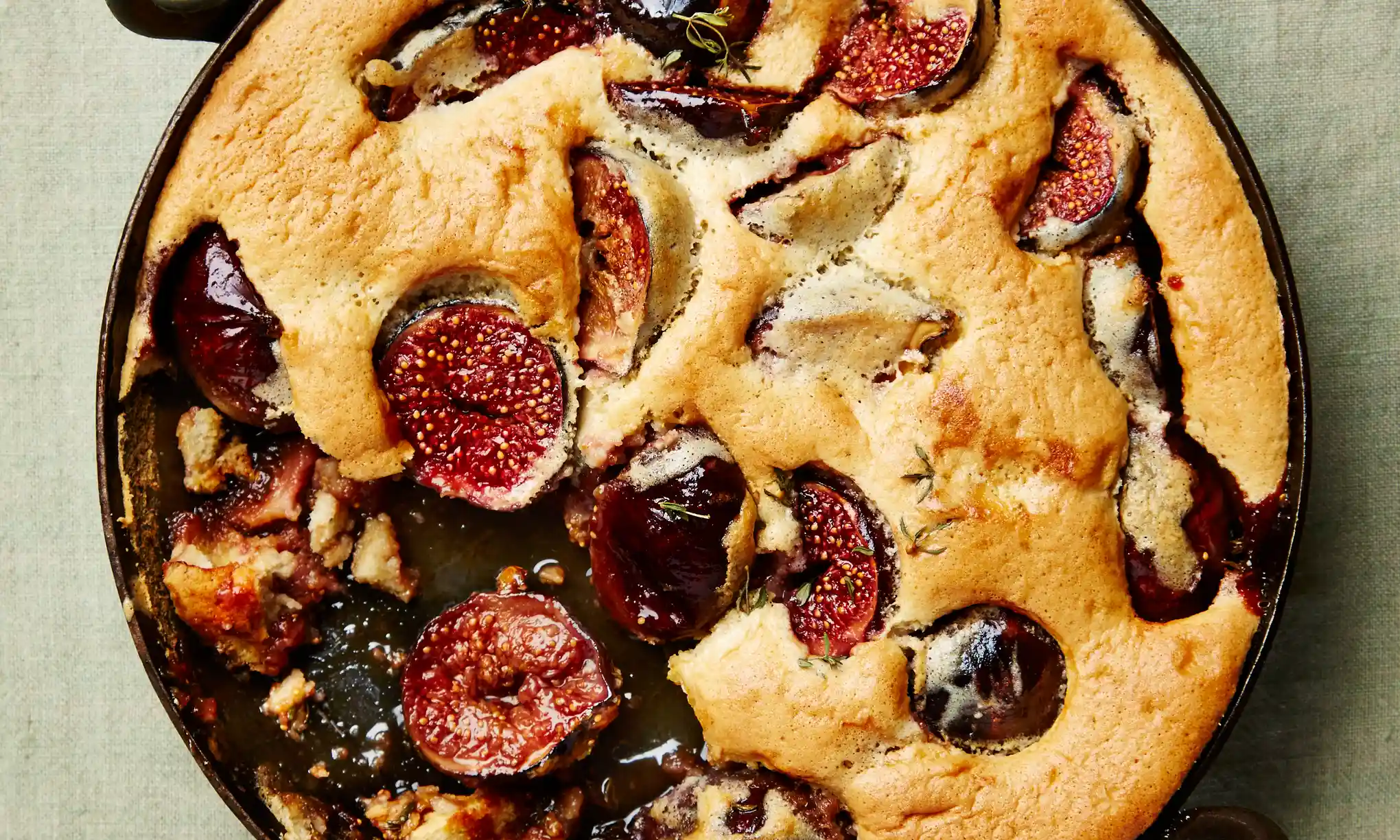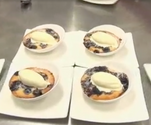Fruit toad in the hole - Clafoutis
- rosemary
- Sep 2, 2023
- 6 min read
"This seemingly simple recipe baffled me for many years, as I endlessly ended up with a leaden duffer of a pud, so much so that I quite gave up on it." Jeremy Lee - (me too)

I am not generally a fan of clafoutis. I have tried cooking it a few times in my life and it's always been very disappointing. Soggy or stodgy - one of those two and always pretty bland. And yet all the chefs rave about it - although I have yet to find any reference to it in any of Elizabeth David's books, which is possibly a bit of a revelation. Did she not like it either? Maybe she failed as well.
Recently though I have come across two different raves about clafoutis from two of my most admired chefs - Nigel Slater and Claudia Roden, so I decided to have another look at it to decide whether to give it another go. It was Claudia Roden who actually tipped me over the edge, because she had a recipe for a plum clafoutis in her book Med, which she claims is a collection of all her very favourite recipes that she cooks all the time. There are not that many desserts, and the clafoutis is one of them. So surely when she can pick from the whole of the Mediterranean it must be good. I cannot find her recipe online, but Nigel Slater's Classic cherry clafoutis is there. Claudia on the left, Nigel on the right.
Nigel has a lot of icing sugar on the top of his, which he defends by saying:
"The dusting of the top with icing sugar is not a conceit: that extra hit of sweetness is really necessary. Like all batters, a short time at a high temperature is the way to go." Nigel Slater
Origins? Well it's supposedly from the Limousin in the centre of France, where they grow the tart morello cherries. So not at all Mediterranean. However, I did find in my Provence the Beautiful Cookbook that Richard Olney suggests that the folk of one particular Provençal town who produce the first cherries of the season in France, also claim it as their own. And yes a true clafoutis has to be cherries. Otherwise it's a flognarde. So Claudia got that wrong. Along with virtually everybody else, because everyone has their own favourite fruit. Indeed Nigel confesses that his favourite is blueberries. As to those origins, well I suspect that it's really a dish that goes back into distant history, because, like its savoury British cousin, Toad in the Hole, it's basic and frugal peasant food really isn't it? They argue about the etymology of the word too. Most think it is from the Occitan word 'claufir' which means to cover or to fill, whilst others go for Latin and 'clave' (nail) and 'figere' (to fix).
So what is it? Well you put some fruit in a dish, make a batter from flour eggs, sugar and milk, pour over and cook in the oven until it puffs up. Sort of a thick pancake I suppose. Simple, but like all simple things, fraught with disaster.

Felicity Cloake has a go at finding the pitfalls when she makes her perfect version, but really the main things I learnt from her were that, the flavour of almonds rather than vanilla was preferable, and that leaving the pips in improved the flavour although your customers should be warned.
"the pits have a particular aroma which infuses the batter as they warm up in the oven, so removing them robs the dessert of its full cherry flavour." Felicity Cloake
Tradition, of course, decrees that the pips should be left in and, of course it's a real pain to pip cherries.

That said, one lady searched YouTube and found this nifty solution. Put your cherry on the next of a bottle and push the stone out with a chopstick. She said it worked a treat, although she did note that her cherries were very ripe. It might not work with firm ones. So wonderful though isn't it that you can find a solution to just about everything on YouTube. Indeed if you watch Jamie and Julia making Julia Child's clafoutis you will see a different solution. Take a solid drinking straw that is about as wide as the pip and punch the cherry with that. Then either blow the pip out of the straw or use a smaller straw to poke it out. Or anything that will fit inside the larger straw I guess. Or combine the two solutions. Use a straw rather than a chopstick. But I do think the cherries would have to be ripe. I wonder whether it would work with olives too?
Felicity is definitely a fan of the concept:
"the combination of sharply juicy fruit and sweet, wobbly batter is a beguiling one." Felicity Cloake
However, she is critical of some of the versions she tried out, including the most famous one from Julia Child et al.

So I checked out Jamie of Jamie and Julia who raved about it and said that it was the easiest of Julia's recipes that he had tried. To confirm this the video is shorter than many of his - a mere five minutes. So why wasn't Felicity a fan? Well Julia is a little bit different in that she makes her batter in a blender - which according to Felicity adds nothing except more washing up, and also cooks some of the batter to an unset pancake like consistency before adding the cherries, which Felicity thought was a bit unnecessary.
Jeremy Lee who provided my opening quote tells a rather lovely story of tasting the perfect clafoutis in Transylvania, extracting the recipe from the chef, and then disappointingly trying it out at home:
"As with recipes close to the heart of the cook, I could not capture the magic of this lovely pudding. It is so often time and place that defines a recipe."

However, he then found Julia Child's recipe, which he adjusted to the greengages (green plums) he had tasted in Transylvania, calling it Plum clafoutis and loved it:
"The result was excellent! I smiled to myself that, like the Wizard of Oz story, it took a trip to Transylvania to make me find a recipe I had had all along; to make a pudding that made – at last – for happy memories."
Proving at the same time that you can make a clafoutis with just about any kind of fruit - and still call it clafoutis. I mean who has heard of flognarde?
"it's a perfect blank canvas for almost any fruit you can think of: from choppable fruits like mango and banana, to cherries preserved in brandy. It's a recipe to draw upon all the year long." John Besh/Epicurious
Of course I found a few variations and you could start by just checking out the Australian Women's Weekly list, but there was also Frozen cherry and smoked salt clafoutis from Anna Jones; a more standard but much praised version from Raymond Blanc/delicious.; Fig and thyme clafoutis from Yotam Ottolenghi; an Individual clafoutis from a French chef called Matthieu Hervé on the SBS website and one from pastry chef Pierrick Boyer - Blackcurrant and almond clafoutis. Blackberry and lavender was another combination I saw somewhere.
Most of the versions shown above are made with summer fruits, which might seem a little counterintuitive because they are hot puddings and they honestly are just a bit stodgy. I think I still stand by that although Nigel Slater seems to think it's OK.
"Batter puddings, where fruit is suspended in a flour and egg batter, are one of the few acceptable hot puddings in summer. Some recipes are soft, like a deflated soufflé, others firmer and puddingy. Most, however, land somewhere between a Yorkshire pud and a custard tart." Nigel Slater
Mmm. Yes, Yorkshire pud. It's wrong somehow. But maybe I should give it one last go. After all it is pretty easy.

POSTSCRIPT
This is my 'guru' dish of the week which we ate last night - Chicken with lemon sauce. Yes I know it doesn't look that marvellous. There are two reasons for that. One I am very bad at 'plating' dishes - making them look gorgeous on a plate, and two - I am not very good at taking photographs of food. But let me tell you this was absolutely delicious, and pretty simple in spite of being in a book called A Taste of Class. The taste was very subtle, but not at all bland. You couldn't quite put your finger on what the taste was. David gave it 4 1/2 stars which is high praise from him. Alas the recipe is not online, but I can send it to you if you feel like giving it a go sometime. I think the only marginal critique I would make is that the sauce didn't emulsify properly. Maybe a little bit more flour, or else a vigorous whisk when you mixed the sauce together. I served it, as Beverley Sutherland Smith suggested, with rice and salad.











Comments